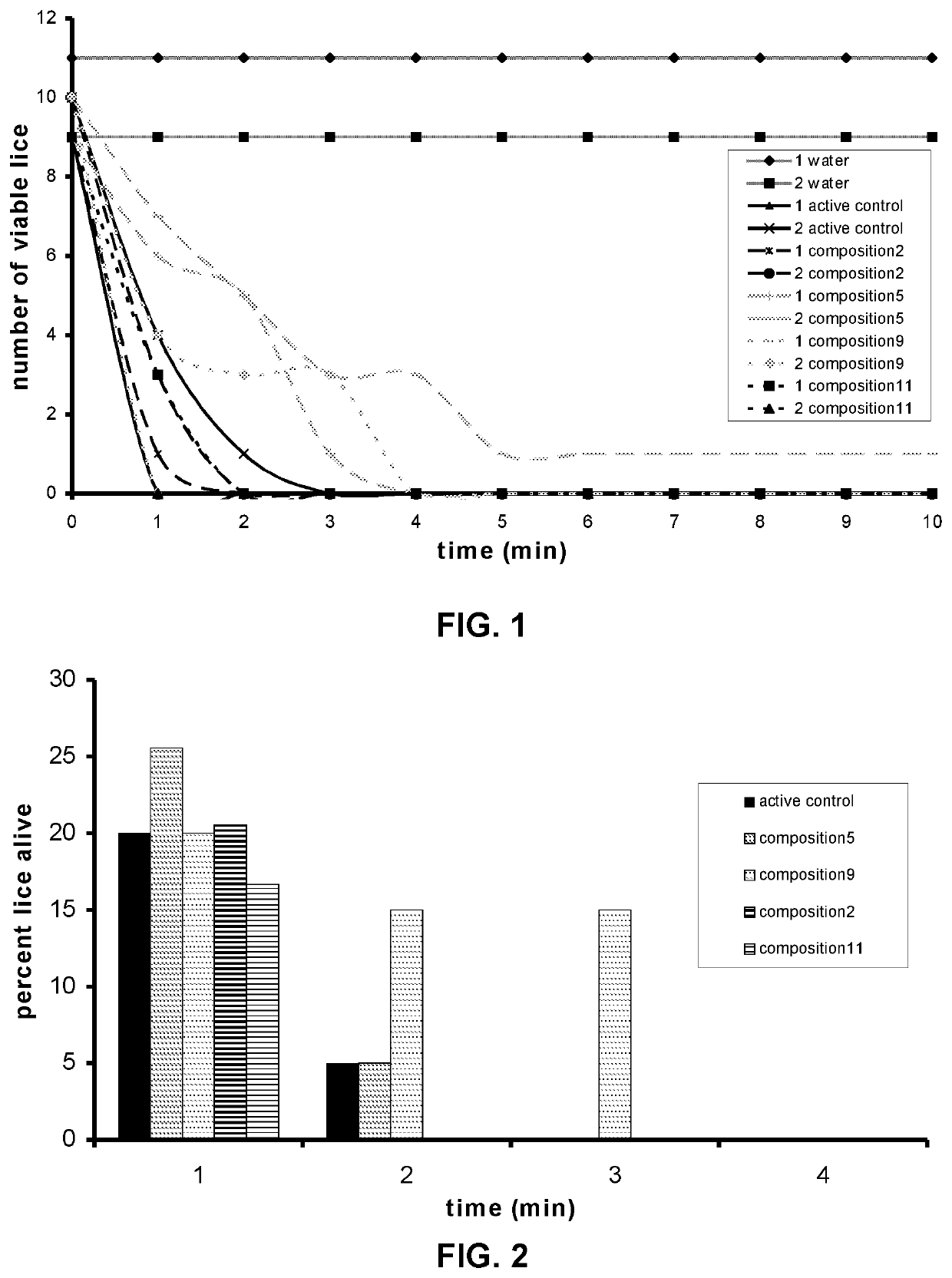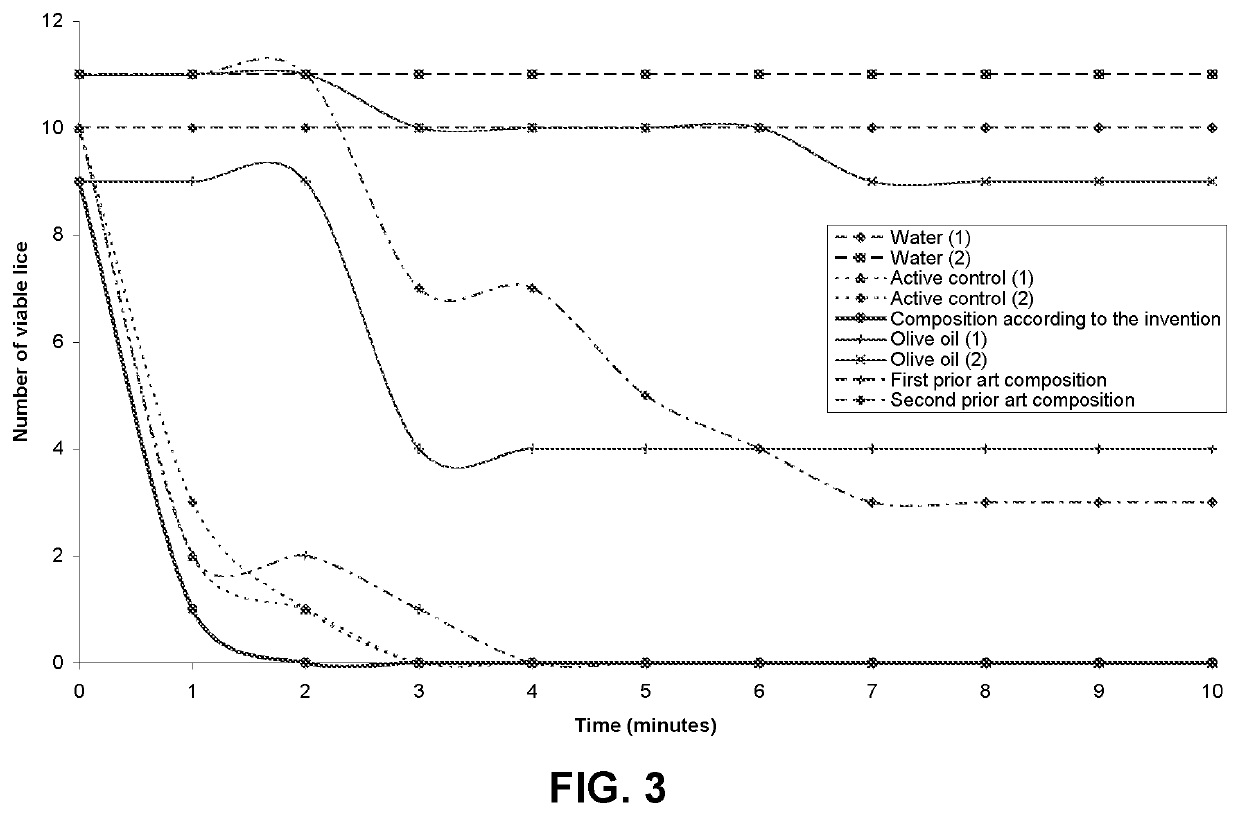Composition for killing arthropods and uses thereof
a technology for arthropods and compositions, applied in arthropodicides, biocides, botany apparatus and processes, etc., can solve the problems of inability to use widely, minor, drawbacks of insecticide compositions, etc., and achieve the effect of high killing
- Summary
- Abstract
- Description
- Claims
- Application Information
AI Technical Summary
Benefits of technology
Problems solved by technology
Method used
Image
Examples
example 1
Screening of Compositions According to the Present Invention for Efficacy Against Lice
[0156]The present invention reports the screening of compositions according to the invention formulations for activity against lice (Trichodectes canis) in vitro.
[0157]In this experiment, the compositions screened were developed to have an impact on the breathing of the lice. These compositions were developed to have a quick impact on human lice infestations. Given the difficulty of working with human lice (safety), dog lice were used in this experiment. Both lice Orders (Anoplura (sucking lice) and Mallophaga (biting lice)) have the same breathing mechanisms. Therefore, it is accepted that the impact of a suffocating composition (i.e. a composition that blocks the spiracles of the parasites) is the same for both Orders.
[0158]Four trials were conducted using a non-active control (water), an active control, and different compositions (4 in each experiment, with 2 repeated). The used compositions are...
example 2
Screening of Compositions According to the Present Invention for Efficacy Against Lice Using Contact Tests
[0191]This experiment is similar to trial 3 and 4 of example 1, using a non-active control (water), an active control, a composition according to the invention, olive oil produced according to the British Pharmacopeia and two prior art compositions, a first one with neem oil as active ingredient (Bioforce Neemcare Riddance) and a second one with permethrin as active ingredient (Lyclear creame rinse, with 1% permethrin). The screened compositions all have an impact on the breathing mechanism of lice. A composition according to the invention comprises 4 wt % dimethicone 60000 censtistokes at 25° C., 48 wt % C13-C15 hydrocarbons and 48 wt % C15-C19 hydrocarbons. The active control consisted of a composition comprising 96 wt % of cyclomethicone and 4 wt % of dimethicone (60000 censtistokes at 25° C.), but no hydrocarbons. Results for this trial are presented in TABLE 5.
[0192]
TABLE 5...
example 3
n of the Foaming Capabilities of a Series of Compositions According to the Present Invention
[0195]In this experiment, a series of compositions according to the invention were screened with respect to their foaming capabilities. The used compositions are depicted in TABLE 6. To assess the foaming capabilities of the compositions a container was filled with the composition. A foam pump was attached to the container and the device was shaken. After this the number of dispenser strokes needed to obtain a volume of 0.04 liter of foam was determined. The foaming capabilities can be assessed in this way since a maximum volume of foam should be obtained with a minimal number of strokes. A poorer foam quality is indicated by a high number of strokes necessary to obtain the volume.
[0196]
TABLE 6Overview of compositions according to the invention and compounds thereof (in weight %) applied in the present experimentdimethiconeDimethiconedimethiconedimethiconeHydrocarbonFoamingN°(3CS)(60000 CS)(1...
PUM
 Login to view more
Login to view more Abstract
Description
Claims
Application Information
 Login to view more
Login to view more - R&D Engineer
- R&D Manager
- IP Professional
- Industry Leading Data Capabilities
- Powerful AI technology
- Patent DNA Extraction
Browse by: Latest US Patents, China's latest patents, Technical Efficacy Thesaurus, Application Domain, Technology Topic.
© 2024 PatSnap. All rights reserved.Legal|Privacy policy|Modern Slavery Act Transparency Statement|Sitemap



